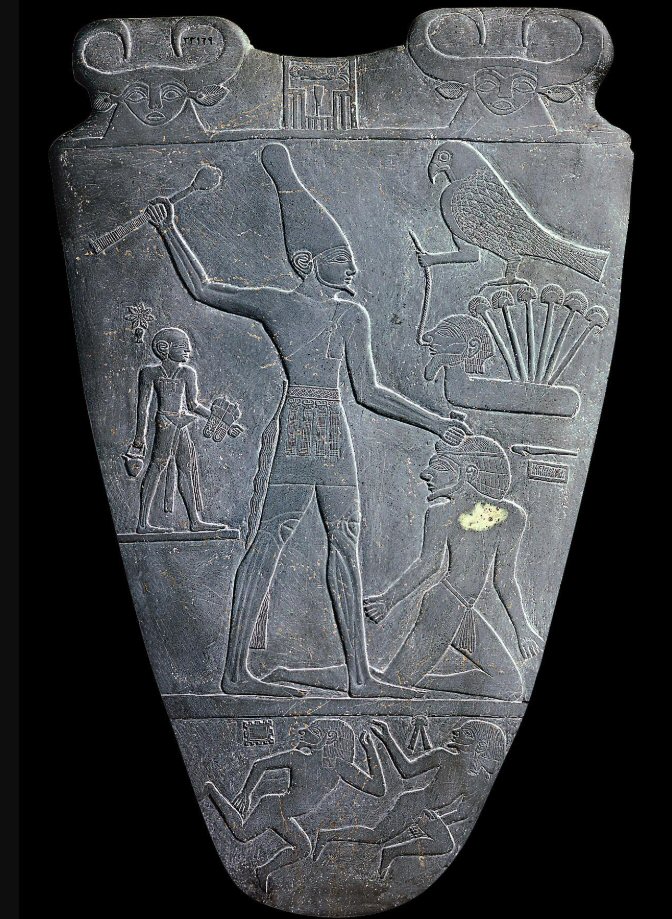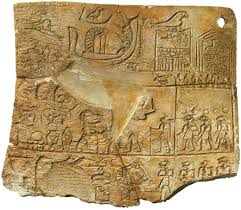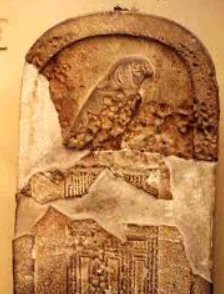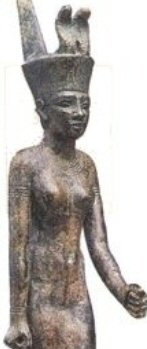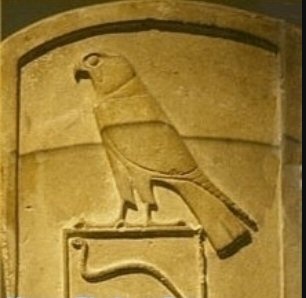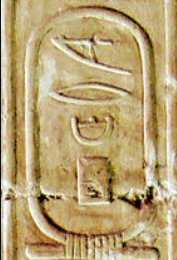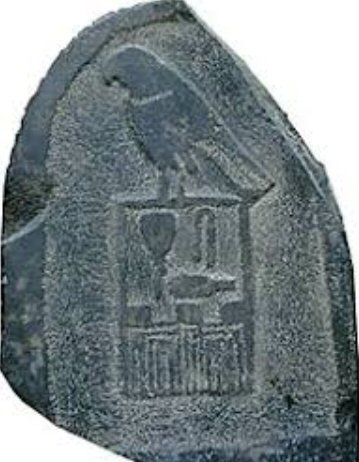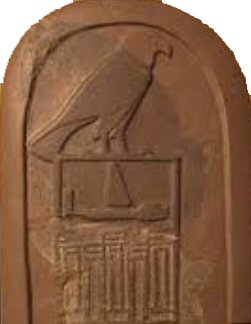Two main changes mark the beginning of the First Dynasty: the spread of writing and the foundation of Memphis.
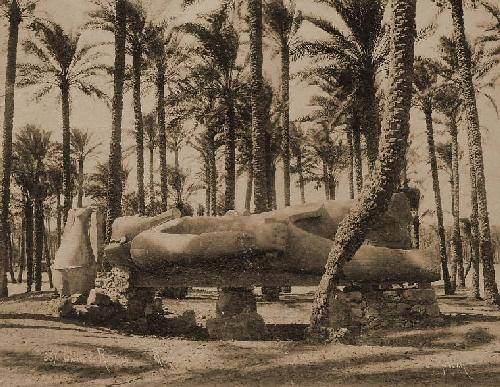
The Egyptians, since the New Kingdom, had been recorded on their Monuments the name 'Menes' as their first king. This was known also in the classical sources such as Manetho's and Herodotus's chronicles. But the name 'Menes' was not found on the monuments of earlier periods. That is why we may suppose that 'Menes' was probably another name for the well-known King Narmer to whom the famous Schist Palette at the Cairo Museum, is attributed.
King Narmer
Narmer is the First Dynasty's first king whose name was known from later King Lists and from classical sources. In their own time, these kings were mostly known by their Horus names and not by their birth names which are used in the lists. As a result, both the identification and the existence of Menes are confused, but he is most probably the same as King Aha, whose reign dates back to the earliest tomb at Saqqara. For this jumble, we are still in doubt whether the three names refer to one, two persons, or three different persons.
King Narmer's tomb was located at Abydos. Some objects dating back to his reign were found in the temples of Nekhen, Hierkonpolis, and Kom el-Ahmar.
A slate palette of green schist displayed at the Cairo Museum is ascribed to Narmer. On the palette's two sides, the scenes are different in their details, yet both commonly commemorate the King's victory over his enemies.
Narmer Palette
Narmer palette is the slate palette of green schist attributed to king Narmer, which is displayed at the Cairo Museum. On the palette's two sides, the scenes are different in their details, yet both commonly commemorate the King's victory over his enemies. In the first register, on both sides, we find the name 'Narmer'(N' r-mr) written inside the rectangular shape that presents the facade of the palace. On other side of the name, the head of the goddess Hathor exists in the face's form of a woman with the ears and horns of a cow. On One Side In the center, we see the King stands, wearing the White Crown and holding an enemy, who is kneeling, from his forehead.
The King holds in his right hand a mace-head to smite the enemy with. In front of the King, we see god Horus in the shape of a falcon, controlling an enemy by a rope tied around his nose. The enemy represented by his head projecting from a horizontal bar. From the bar, 6 papyrus stems are raised behind the enemy's head and on which is resting the leg of the falcon. Each stem gives the number 1000. This indicates that god Horus controlled the enemies of the King, and that he presented 6000 captives among them. Behind the King is his sandal-bearer holding in one hand a jar, while in the other, the King's sandals. In the last register, we find 2 enemies fleeing, above each one of them, the king's name is inscribed.
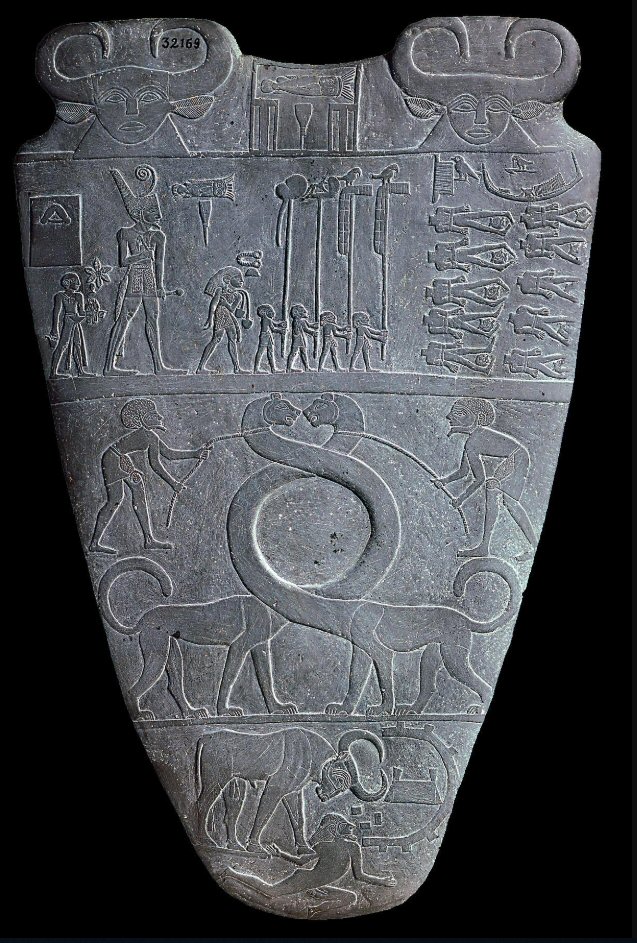
On other side In the second register, we find king Narmer wearing the Red Crown and his sandal-bearer is standing behind him. In front of the king, another high official preceded by the standard-bearers who carries emblems at the top of the standards. At the right end of this register, we see 2 rows of enemies, each of their heads was cut, their hands tied behind their back and their legs twisted towards inside, except 2 enemies standing in the first row. Perhaps these two were the chiefs of enemies. Also, we see, the King marches in a procession with his officials and the standard-bearers of his armies viewing the captured bodies of the Northern enemies.
In the third register, we find two animals with long necks which intertwine to form a circle in the middle. Two attendants hold these animals by means of ropes to stop them fighting. In the fourth register, the King stands at the front of a bull attacking a fortress with his horns. The scenes on this palette are for commemorating Narmer's victory in his war against Northerners.
King Hor Aha
The name "Hor-aha" means the Fighter. On King Aha's monuments, there are some indications mentioning his wars against the Libyans and the Nubians. Moreover, there is a reference to some religious ceremonies like his coronation ceremony.
After Narmer's death, Hor-aha ascended the throne and became the first king of the First Dynasty. Perhaps, he may be identified with Menes of the classical historians. In that case, he would be the founder of the Thinite Period (First Dynasty). If he was the same person as Narmer, then he was the cult inaugurator of the Crocodile-god, Sobek in the region of Faiyum as well as the Memphis founder (some 20 miles south of the apex of the Delta, near the natural frontier between the North and the South). He chose this place to be the capital Memphis, because of its strategic position to control both Upper & Lower Egypt. Memphis was at the top of Upper Egypt and belonged to Lower Egypt. Aha controlled the Northerners, and settled in Lower Egypt to be ready to attack the Northerners at any time. This was the place of the different Egyptian capitals through ages.
The new capital was known as Mn-nfr and latter on, Memphis. Manf was called 'The White Wall', which is the wall surrounding the country.
According to this strategic point, Hor-aha ruled the newly-united Egypt where he took his new capital and built a great temple dedicated to the god Ptah, who remained the patron deity of the city throughout its long history. Here also, on the desert edge behind the city, he set up his northern tomb, the first of a long series of funerary monuments which were to be built by his successors. He would probably have established both his administration and the cult of the Apis-Bull at Memphis. It is likely that he also organized the newly unified land by starting a policy of conciliation with the North, which is deduced from the fact that the name of his wife, Neith-hotep (may Neith be pleased), which was formed from the name of the goddess Neith, originally worshipped at Sais in the Delta. The tomb of Neith-hotep, excavated at Niqada, was provided with a large amount of objects including a tablet bearing the name of Aha.
It seems that Aha founded a temple of Neith at Sais and celebrated the festivals of Anubis and Sokar as well as his own royal jubilee or Sed-festival.
Aha Reign was peaceful, except for a series of wars against the Nubians that he defeated. Later, he established his rule as far up river as the first cataract. He also defeated the Libyans and established trade relations with Syria and Palestine. These military and economic initiatives were bore by his successors. The reign of Aha, which must have ended about 3100 BC, was thus reasonably well-documented. He had two tombs: one at Saqqara and the other at Abydos.
King Djer
Djer's daughter was Queen Meryt-Neith, whose tomb has been excavated in the royal necropolis at Abydos. Djer Reign is characterized by further developments in foreign policy, that include expeditions to Nubia, Libya and Sinai. He also set the economic and religious organization of the country and built a palace at Memphis and a tomb for himself at Abydos, where he may even have been the historical prototype of Osiris. Two great tombs belonging to Djer were found at Abydos and Saqqara. For some reasons, the Ancient Egyptians in a later period thought that Djer's tomb at Abydos was the tomb of Osiris. They performed pilgrimage to it and presented offerings until it was assured that it is the tomb of Djer by archaeological discoveries. He was buried along with the rest of his court, although this does not necessarily mean that his courtiers were obliged to die violently to accompany their sovereign into the grave. However, this was the first case of the pharaoh's recognition of the funerary needs of his subordinates.
Djer Reign was a time of great prosperity, due to the funerary furniture in the private tombs of his contemporaries. Djer continued Hor-aha's wars against the Nubians and established his rule as far up river as the second cataract. This important event is engraved on a sandstone slab which was found on Gebel Sheikh Suliman, about 11 km south of Wadi Halfa. This slab has been cut and transferred to Khartoum where it is now in the garden of the new museum. It shows that the kings of the 1st Dynasty were interested in safegardining the southern borders of Egypt and in invading the areas to the south of the first cataract for the trade movement with Sudan. Recent excavations at Saqqara have brought to light a large tomb belonging to Her-Neith who might have been his wife.
Queen Meryt-Neith
Queen Meryt-Neith is the first queen who ruled as a king over Egypt, like queen Neith-Hotep. Her name is associated with goddess Neith. There were two huge tombs for her: one is at Saqqara close to the capital of the newly-unified country and the other is at Abydos in Upper Egypt.
Different opinions were expressed concerning Queen Meryt-¬Neith. Had she ruled over Egypt or simply had she been a king's consort? We have no decisive proof that she ever ruled as a king, as she was not on any of the King-Lists. However, Meryt-Neith was known in the history of Egypt, during the time when the written records were somewhat obscure.
The problem with Meryt-Neith first came to light in 1900 AD. Her tomb was discovered among kings at Abydos. Meryt-Neith's name was inscribed on her tomb's wall, so in the beginning, the name was accepted to be referring to a male king. Based on this evidence, Meryt-Neith was classified as a king, possibly the third ruler of the 1st Dynasty. Later on, it became apparent that the name, Meryt-Neith, is actually for a female and it means 'beloved of Goddess Neith'. At that point, Meryt-Neith was accepted to be re-classified as a powerful king's consort. This view is supported by the discovery of few seals bearing Den's name inside her tomb at Abydos, so some scholars assumed that she must have been his wife. Some objections have been raised against this opinion due to the fact that Den's tomb which is next to Meryt-Neith's tomb was plundered. This may suggest that the contents of both tombs have been mixed up together. We know now that Meryt-Neith had another tomb at Saqqara where she had a solar boat, which was believed to be granting her spirit to travel with the Sun-god in the Afterlife, an honor reserved normally for the king.So Meryt-Neith, by having two tombs, became the only woman known to have been commemorated in this way. This strongly suggests that she may have been a ruler or at least a co-regent rather than a mere consort.
King Wadjet or Djet
His name means Serpent. He led an expedition to the Red Sea, perhaps with the aim of exploiting the mines in the Eastern Desert. His name has been found engraved on the rocks of one of the routes in the Eastern Desert which connected between Edfu and the Red Sea.
Two tombs belonging to Djet have been discovered at Abydos and Saqqara. His tomb at Abydos contained numerous stelae, including a magnificent limestone example inscribed with his Horus name. Moreover, a third tomb was discovered at Nazlet el-Batran, near the Giza archeological site, in which his name was found, engraved on its objects. Probably this tomb belongs to a member of his family or a high official. Throughout his reign, Egypt achieved a high degree of progress.
King Den -Udimu
At the beginning of his reign, Den worked on limiting the power of the High Court officials, which had previously been allowed to grow dangerously during Meryt-Neith's regency.
He followed a foreign policy which drew his attention to the Near East with an 'Asiatic' campaign in the first year of his Reign. He also brought back a harem of female prisoners (which later on was copied by Amenhotep III). This military activity was taken along with an expedition into Sinai to deal with the Bedouins.
Den was the first king who added to his tutelary the nsw-bity title, which was evidently intended to reflect his active internal policy. This included the building of a fortress and the celebration of religious ceremonies honoring the gods Atum and Apis. He also seems to have followed a policy of conciliation with northern Egypt, which was expressed not only through the name of 'his wife' Meryt-Neith but also by the creation of an office 'Chancellor of the King of Lower Egypt'. Hemaka assumed this post, and his tomb was discovered at Saqqara.
The tomb was built by Den at Abydos, a granite pavement was found, the first known example of stone-built architecture, and then had exclusively been a mud-brick.
Den Reign is estimated to have been lasting nearly 50 years. There are many inscribed labels and jar-sealing that bear Den's name. Besides, there are records which narrate the activities performed throughout his reign. We know a great deal of him from his tombs, his officials' tombs and from the Palermo Stone.
King Adjib
The name "Adjib" means 'the one with the bold heart'. The other name of King Adjib – being the King of Upper and Lower Egypt –was Merpubia. He probably ascended to the throne late in life. It was in Adjib's reign that the 'Two Lords' name (the name placed under the protection of Horus and Seth) were introduced. This title re-united the two divine antagonists of the North and the South in the King's person.
King Semerkhet
His Horus name was 'companion of the gods', and his Nebty name was 'he whom the two mistresses guard'. He certainly attempted to emphasize his legitimacy by erasing Adjib's name from his jubilee vases. This legitimacy was called into question with the omission of Semerkhet's own name from the Saqqara King-List. His tutelary certainly indicates a previous career, perhaps in a priestly role, before ascending the throne.
King Qa-aa
He is the last king in the First Dynasty. His tomb at Abydos included several jar sealing and labels upon which his Horus name was written. His tomb at Saqqara, unearthed in 1954, was found to be a vast building measuring 65 x 37 meters. From the scenes in the tomb we could get much information about the names of his high officials and the positions which they occupied. This brings in light the administrative system of the country. For some officials were supervisors on projects of irrigation, taxes collection and the registration of events.
The end of the First Dynasty is rather problematic, since it is clear that the unusually long duration of Den Reign had led to a struggle for succession to the throne after his death. Both Semerkhet and his successor Qa-aa were buried at Abydos. By Qa-aa Reign, the First Dynasty witnessed its end. At the turn of this Dynasty, the centre of power seems to have been moved to Memphis. This is according to the fact that at least the first three kings of the Second Dynasty were buried in the Saqqara Necropolis, which indicates that the centre of power had been moved to Memphis. Another indication of this power shift was the name of the first ruler of this dynasty.
